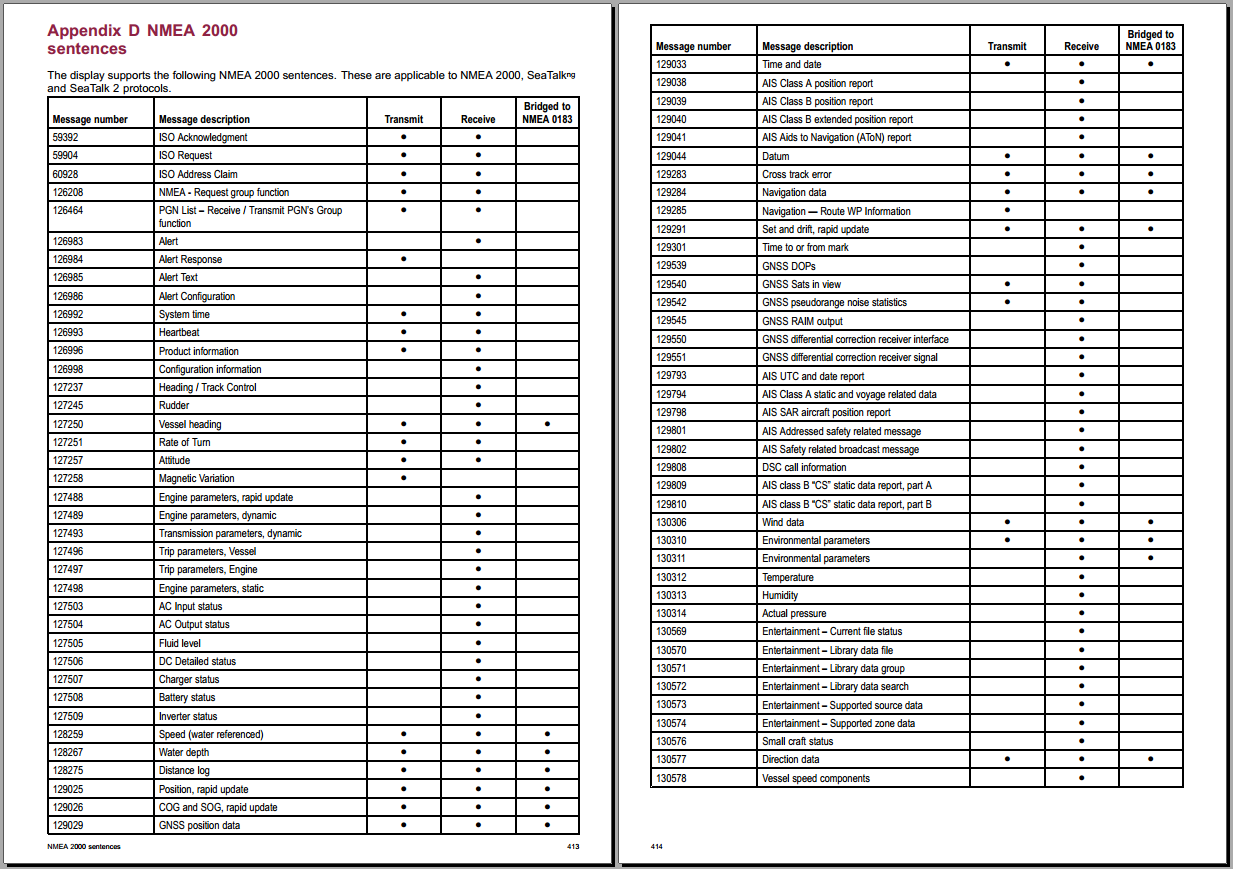Protocole
NMEA 2000 Protocol
NMEA 2000 (National Marine Electronics Association 2000) is a standardized protocol used in the marine industry to enable communication and data exchange between various marine electronic devices and sensors on a boat or ship. It was developed to provide a common language for marine equipment, ensuring interoperability between devices from different manufacturers.
Key Features:
Data Exchange: NMEA 2000 allows different marine devices, such as GPS systems, depth sounders, chart plotters, engines, and sensors, to exchange data seamlessly. This includes information like position, speed, heading, depth, temperature, and more.
Physical Layer: NMEA 2000 uses a Controller Area Network (CAN) bus as its physical layer. The CAN bus is known for its reliability and ability to handle real-time data transmission, making it well-suited for marine environments.
Standardized Messages: The protocol defines a set of standardized messages or "PGNs" (Parameter Group Numbers) that specify the format and content of data. Each PGN has a unique identifier, making it easy to identify the type of information being transmitted.
Multi-Device Support: NMEA 2000 networks can accommodate multiple devices, allowing for the connection of various sensors, displays, and control units on a single network.
Plug-and-Play: Devices compliant with the NMEA 2000 standard can be easily added or removed from the network without the need for complex configuration. This plug-and-play nature simplifies installation and maintenance.
Power Efficiency: NMEA 2000 networks are designed to be power-efficient, making them suitable for marine applications where power conservation is crucial.
Common Applications:
NMEA 2000 is commonly used in various marine applications, including:
Navigation Systems: It facilitates the exchange of GPS data, navigation information, and waypoints between GPS receivers, chart plotters, and autopilots.
Engine Monitoring: NMEA 2000 allows for the real-time monitoring of engine parameters such as RPM, fuel consumption, oil pressure, and temperature.
Weather and Environmental Sensors: Marine weather stations and environmental sensors can provide data on wind speed, water temperature, barometric pressure, and more via the protocol.
Instrument Displays: Data collected from various sensors can be displayed on instrument panels or multifunction displays.
AIS (Automatic Identification System): AIS transponders use NMEA 2000 to broadcast vessel information for collision avoidance and maritime safety.
Sailboat Performance Monitoring: Sailboats use NMEA 2000 to monitor sail trim, wind direction, and other performance-related data.
Structure of NMEA 2000
The NMEA 2000 protocol is structured to facilitate communication and data exchange between marine electronic devices. It defines a set of rules, message formats, and network components to ensure compatibility and interoperability. Here are the key components of the NMEA 2000 structure:
NMEA 2000 Network: The physical layer of NMEA 2000 is based on a Controller Area Network (CAN) bus. This network connects all NMEA 2000-compliant devices on a boat or ship.
CAN Bus: The BUS CAN is a two-wire communication bus that allows for the transmission of data between devices. It's known for its reliability, efficiency, and real-time capabilities, making it suitable for the marine environment.
2. Messages and PGNs (Parameter Group Numbers):
Messages: Communication in NMEA 2000 is message-based. Devices send and receive messages to exchange data. These messages can contain information about vessel navigation, engine parameters, weather data, and more.

PGNs: Parameter Group Numbers (PGNs) are unique identifiers assigned to each type of message. PGNs define the format and content of the data. For example, a PGN might be used to transmit GPS coordinates, while another PGN could be used for engine RPM.

3. Devices and Sensors:
- NMEA 2000 Devices: These are the electronic components and sensors that are part of the NMEA 2000 network. They include GPS receivers, chart plotters, depth sounders, engines, temperature sensors, wind instruments, and more.
4. Connectors and Cabling:
Connectors: NMEA 2000 connectors are used to physically connect devices to the CAN bus. Common connector types include Micro-C, Mini, and DeviceNet connectors.
Cabling: NMEA 2000 cabling connects devices in the network. It consists of a backbone cable and drop cables to connect individual devices.
5. Data Interpretation:
- Data Interpretation: The data received via NMEA 2000 messages needs to be interpreted by receiving devices. Each device knows which PGNs it's interested in and how to process the data contained in those messages.
6. Interoperability:
- Manufacturer IDs: NMEA 2000 assigns unique manufacturer IDs to ensure that devices from different manufacturers can coexist on the same network. This helps in maintaining interoperability.
7. Power Management:
- Power Conservation: NMEA 2000 networks are designed to be power-efficient, especially important on boats where power resources may be limited.
8. Configuration and Installation:
- Plug-and-Play: NMEA 2000 networks are known for their plug-and-play nature, making installation and configuration relatively straightforward.
The structured approach of NMEA 2000 ensures that marine devices can communicate effectively, allowing for real-time data exchange and enhancing the overall safety and functionality of vessels.
Conclusion:
NMEA 2000 has become the de facto standard for marine electronics communication, ensuring compatibility and interoperability among devices from different manufacturers. Its plug-and-play nature, standardized messages, and support for various marine applications make it a vital component of modern marine navigation and monitoring systems.